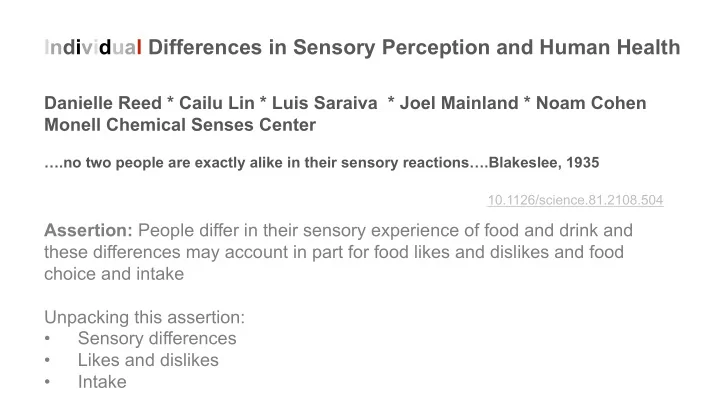

Individual Differences in Sensory Perception and Human Health Danielle Reed * Cailu Lin * Luis Saraiva * Joel Mainland * Noam Cohen Monell Chemical Senses Center ….no two people are exactly alike in their sensory reactions….Blakeslee, 1935 10.1126/science.81.2108.504 Assertion: People differ in their sensory experience of food and drink and these differences may account in part for food likes and dislikes and food choice and intake Unpacking this assertion: • Sensory differences • Likes and dislikes • Intake
Sensory differences are common 2-ethyl fenchol – mushroom Beta-ionone – violets Capsaicin – burning, spicy Citric acid – sour Galaxolide – musk Guaiacol – liquid smoke Menthol – cooling NaCl – salty PEA – phenyl ethyl alcohol - rose PTC – phenylthiocarbamide – bitter Sucralose – high potency sweetener TMA – trimethylamine - fish https://www.perfumerflavorist.com/flavor/research/video-Building-a-Taste- 2 Genome-with-Monells-Flavor-Quiz-508763101.html
Scale of big data and genome wide association studies Study N Reference NHANES (taste and smell data) 3,603 10.1093/chemse/bjv057 UK Biobank 455,146 10.1101/662239 Ongoing Million Veterans Program All of Us 3
Scale of big data and genome wide association studies Study N Reference NHANES (taste and smell data) 3,603 10.1093/chemse/bjv057 UK Biobank 455,146 10.1101/662239 UK Biobank - what data are available? Genotypes, 13,791,467 markers Food intake, up to four 24-hour diet recalls No taste or smell data except ICD-10 codes 4
About how many pieces of FRESH fruit would you eat per DAY? (Count one apple, one banana, 10 grapes etc as one piece; put '0' if you do not eat any)" Please provide an average considering your intake over the last year 5
Fruit intake data from the UK Biobank 6
GWAS: Breaking it down 7
Statistical significance is striking but effect size is small 8
Post GWAS studies: Related phenotypes and PheWAS# mRNA and protein expression Function #PheWAS == one variant, many or all phenotypes (traits) 9
10
OR6B1 variants are associated with strawberry ice cream preference OR6B1 https://blog.23andme .com/23andme- research/you-scream- i-scream-our-genes- scream-for-ice-cream/ 11
Post GWAS studies: Related phenotypes and PheWAS mRNA and protein expression Function 12
Olfactory epithelium tissue for mRNA transcript profiling by endoscope 13
OR6B1 mRNA is highly expressed in human olfactory receptor neurons 10.1126/sciadv.aax0396 Normalized mRNA transcript counts All olfactory receptors, rank ordered by average counts in humans 14
OR6B1 is not expressed in other tissues tested except testes https://www.gtexportal.org/home/gene/OR6B1 15
Post GWAS studies: Related phenotypes and PheWAS mRNA and protein expression Function 16
Olfactory receptor functional assay 1. Olfactory receptors are GPCRs; activated, they produce cAMP 2. We transfect cells with (a) the receptor (genotypes) and (b) a reporter 3. When an odor is delivered, the cells glow yellow 4. Light production increases as odor amount increases for a dose-response curve 17
Luciferase Assay Normalized Response 100 OR7D4 RT OR7D4 WM 75 50 25 0 0 -6 -5 18 [androstenone] (log M)
Cell-based assays to find flavor ligands for olfactory receptors OR2A25 (near OR6B1) but no ligands yet for OR6B1 Different genotypes SVA NAP NVP NVA SVP 10.1073/pnas.1804106115 Linalool – found in essential oils and many plants 19
Wrapping up • Sensory differences are common • Fruit intake GWAS points to olfactory receptors (OR) • Functional OR studies are underway Future • Volatile cheminformatics common to many fruits 20
Looking ahead Scale and big data • Data scientists trained in chemosensory biology and nutrition • Phenotyping, chemosensory measures and food intake data Public policy, medicine and food implications • Using genetic information for the forces of good • Tailoring foods including plants 21
Most significant associations are on top of OR6B1 , an olfactory receptor 22
Genetic variants on human chr 7 and fresh fruit intake 23
The consensus OR for subfamily hOR6 has ethyl 3-methyl-3-phenylglicidate (also known as 'strawberry glycidate’) and 3-methyl-1-butanethiol as top ligands https://www.biorxiv.org/content/biorxiv/early/2019/04/10/605337.full.pdf 24
81+ volatile compounds from strawberries 10.1371/journal.pone.0088446 25
Recommend
More recommend